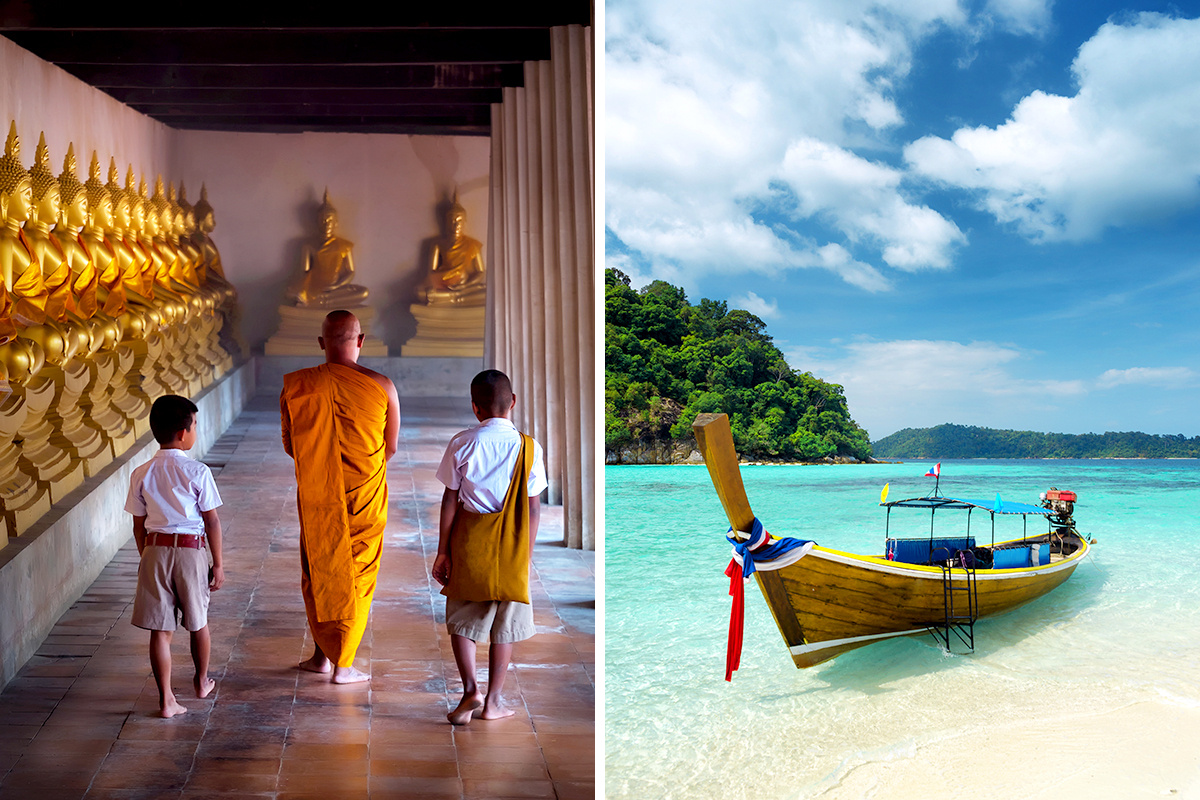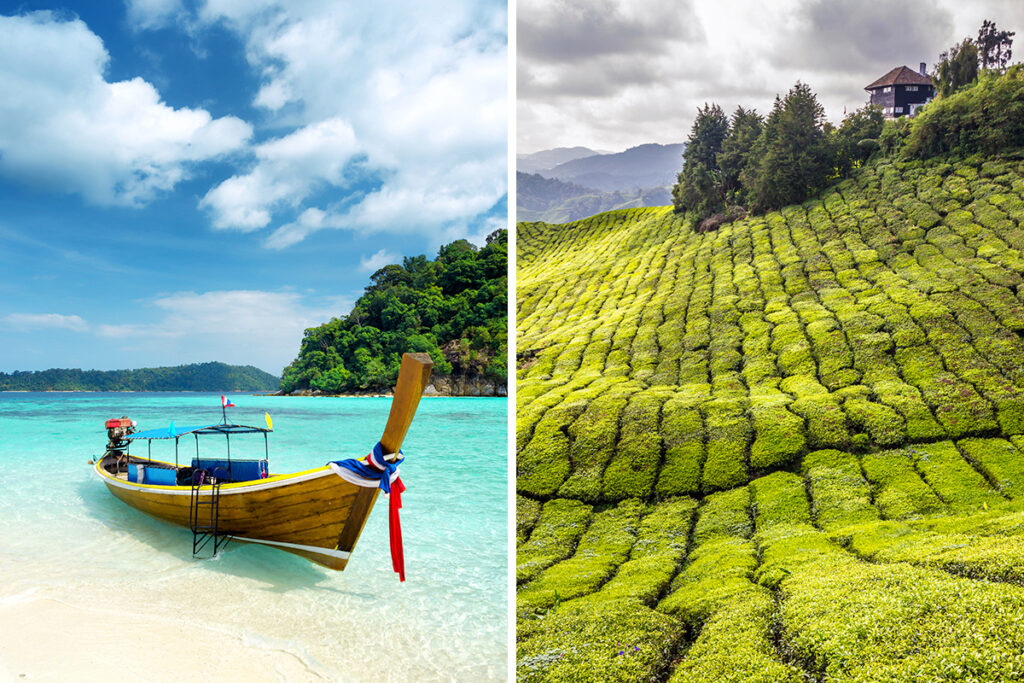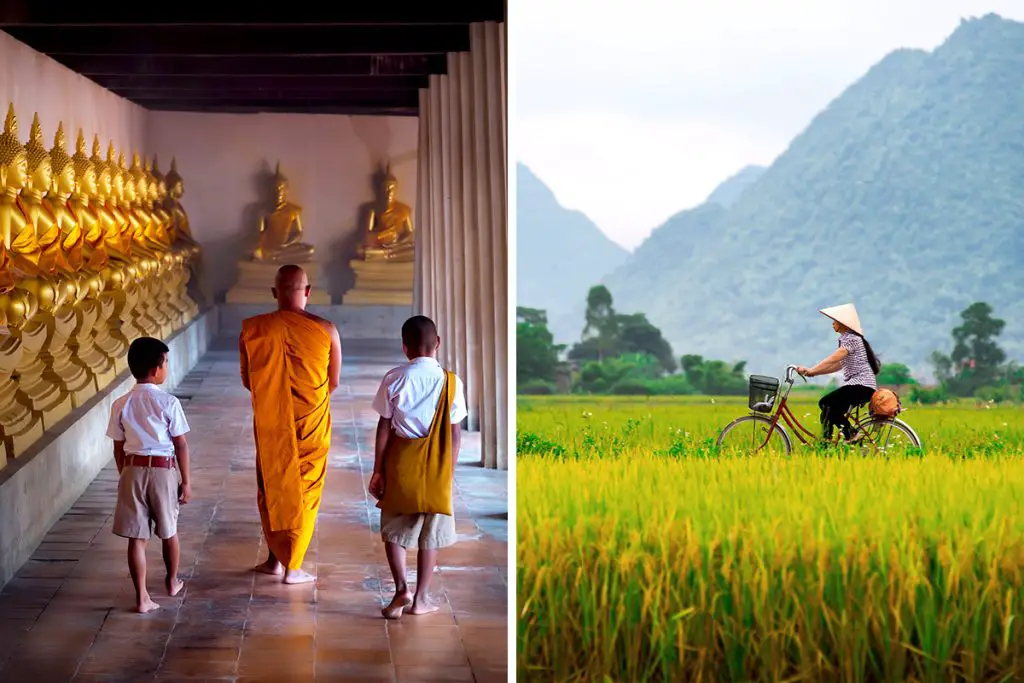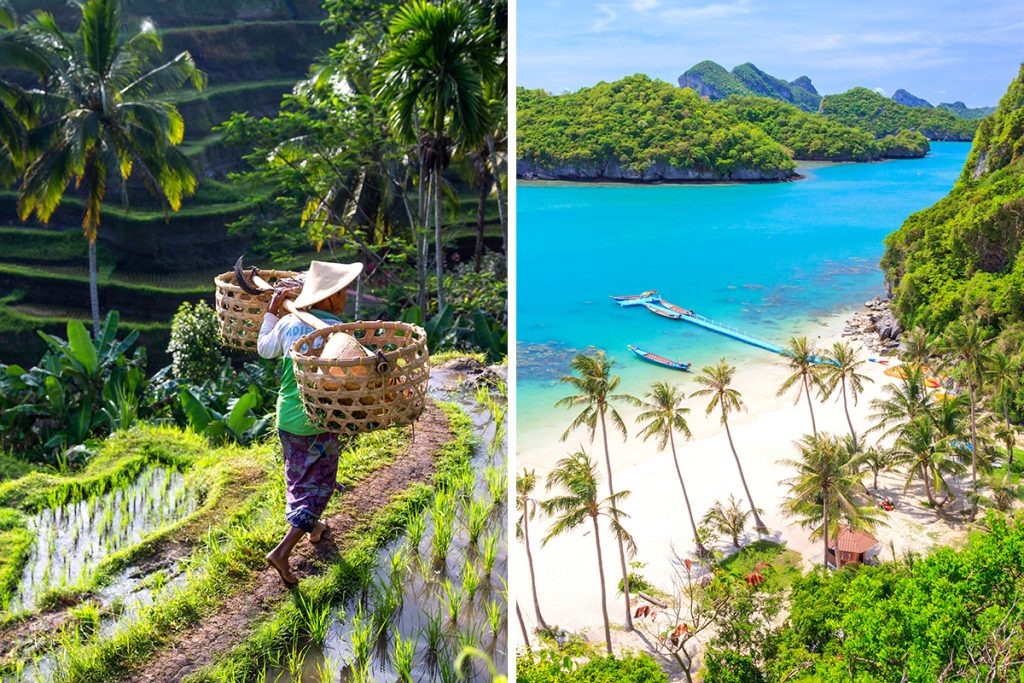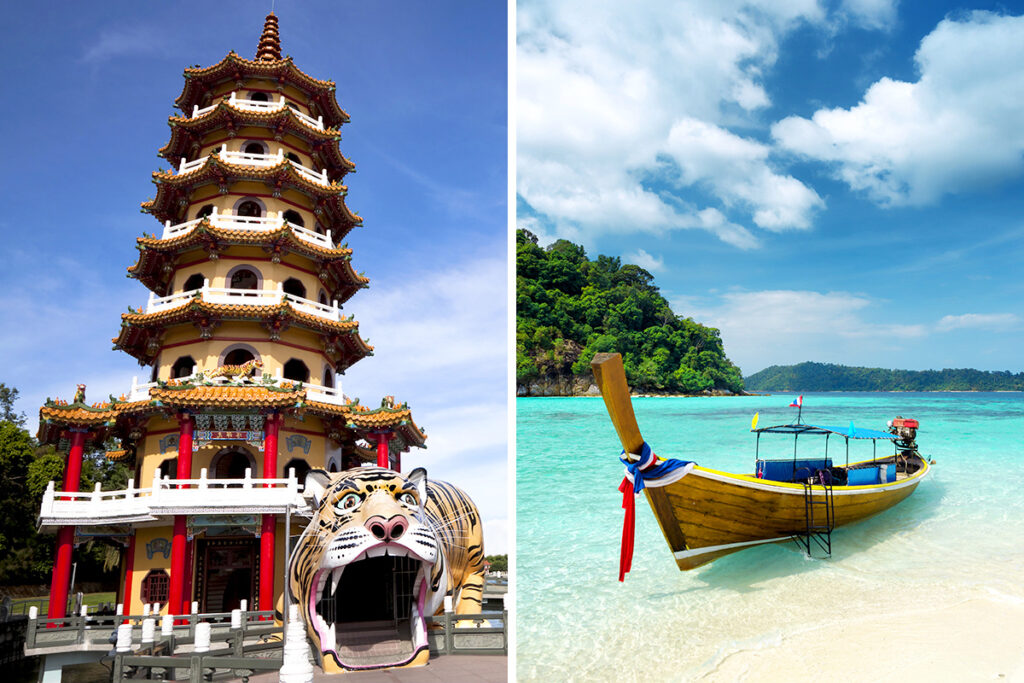Dive deeper into the essence of these two Southeast Asian neighbors. The choice can be challenging, as each country boasts its own unique allure and captivating traditions. Ready to explore the subtleties that set them apart?
History & Culture
So, you’re intrigued by the history and culture of Southeast Asia. Both Laos and Thailand offer rich traditions and stories that span centuries. Let’s pull back the curtain on each of these countries to help you make an educated decision.
Laos is often seen as the underdog in Southeast Asia, but don’t underestimate its cultural depth.
Predominantly influenced by Buddhism, the country showcases intricate temples and a slower pace of life that allows you to immerse in its history. Ancient cities like Luang Prabang give you a taste of royal grandeur, while local traditions like the alms-giving ceremony connect you directly to its spiritual core.
On the flip side, Thailand is a fusion of the modern and the ancient. From bustling Bangkok to tranquil Chiang Mai, the country is a melting pot of cultural experiences.
Buddhism also plays a significant role, but the Thai culture is a unique blend of various influences, including Hindu and Khmer. This makes Thailand’s historical landscape diverse, with palaces, temples, and even its own unique form of dance and martial arts.
When it comes to festivals, Laos and Thailand don’t hold back. Laos celebrates its New Year, known as Pi Mai, with grand processions and water fights. The festival is not just an occasion but a reflection of Laotian unity and tradition.
Thailand’s Songkran is equally spectacular, featuring its famous water fights, but with a more cosmopolitan flair. These festivals are windows into the countries’ respective cultures.
If language fascinates you, both countries have their own unique scripts and dialects. In Laos, the Lao language dominates, while in Thailand, the Thai language reigns. While both are part of the Tai-Kadai language family, they are distinct enough to set the countries apart culturally.
In summary, if you’re leaning toward a tranquil, deeply spiritual experience, Laos might be the destination for you. But if you’re seeking a dynamic blend of old and new, with a sprinkle of cosmopolitanism, Thailand could be your perfect fit. Whichever you choose, you’re guaranteed an enriching, culturally immersive experience.
Attractions & Activities
Embarking on an adventure in either Laos or Thailand promises a kaleidoscope of memorable experiences. From ancient wonders to natural splendors, each country offers its own set of can’t-miss attractions and activities. Let’s delve into what sets them apart so you can tailor your journey to your interests.
Laos may not be as popular as Thailand, but it packs a punch when it comes to attractions. Think about exploring the karst mountains in Vang Vieng or taking a peaceful boat ride down the Mekong River.
A must-visit is the Kuang Si Falls, a stunning multi-tier waterfall located 29 kilometers (about 18 miles) from Luang Prabang. The turquoise blue pools are not just beautiful to look at; they also invite you for a refreshing swim.
If you’re historically inclined, the mysterious Plain of Jars, scattered with ancient megalithic stone jars, is worth the visit.
Thailand, in contrast, offers a wider variety of attractions, both natural and man-made. For instance, the ancient city of Ayutthaya, located about 85 kilometers (around 53 miles) from Bangkok, invites you to walk through ruins that were once the epitome of grandeur.
For nature lovers, the Erawan National Park offers a seven-tiered waterfall that provides a beautiful hiking experience. Or consider visiting Chiang Mai to witness the spectacle of the Yi Peng Lantern Festival, where thousands of lanterns illuminate the sky.
Adventurous spirits are equally at home in either country. Laos offers thrilling activities like caving in Kong Lor Cave or trekking through the mountainous terrain in Luang Namtha. In Thailand, rock climbing in Krabi or kayaking through the limestone caves in Phang Nga Bay provides adrenaline rushes that are hard to beat.
Culturally, both countries offer unique experiences as well. Traditional Laotian dance shows in Luang Prabang or Thai classical dance performances in Bangkok provide a cultural framework to your journey, enriching it with traditional melodies and choreography.
To sum it up, Laos is your go-to for an intimate, nature-driven experience with a touch of mystery and spirituality. Thailand, meanwhile, offers a smorgasbord of attractions ranging from ancient cities to thrilling outdoor adventures. Your choice will depend on what type of experiences speak to your soul.
Beaches
Ah, the allure of sandy shores and turquoise waters. Both Laos and Thailand offer seaside experiences, but they are as different as night and day. Let’s wade through the distinctions to help you choose your ideal beach destination.
First off, it’s essential to know that Laos is landlocked, meaning no ocean beaches. However, it does have its own version of a beach experience on the banks of its mighty rivers.
The Mekong River, for instance, has sandy shores, particularly in the 4000 Islands area, where you can relax, sunbathe, or even take a dip. The distance to this area is roughly 718 kilometers (about 446 miles) from the capital, Vientiane.
In Thailand, you’re spoiled for choice with numerous coastal beaches along the Andaman Sea and the Gulf of Thailand. One standout is Railay Beach, approximately 783 kilometers (about 487 miles) from Bangkok. Known for its stunning limestone cliffs and clear waters, it’s a paradise for those seeking a quintessential beach experience.
Both countries offer water-related activities, albeit differently. In Laos, tubing down the Nam Song River in Vang Vieng has been a backpacker favorite. In Thailand, activities are more diverse, ranging from snorkeling to scuba diving in places like Koh Tao.
Temperature-wise, Laos’ river beaches are generally warmer, given the country’s tropical climate. Thailand’s beaches offer more temperature variety, depending on whether you’re in the Andaman Sea or the Gulf of Thailand. Generally, expect warmer waters in the Gulf.
To summarize, if you’re in search of a unique, less conventional beach experience, the riverbanks of Laos offer a charming alternative. But if the call of the ocean is too strong to resist, Thailand’s extensive coastline is your haven. The choice is yours, depending on what you seek from your water-bound experience.
Choosing between Laos and Thailand for your next adventure can be a tough nut to crack. On one hand, Laos offers an intimate experience with its rich history and mesmerizing natural attractions. On the other, Thailand tempts with its vast array of activities and paradisiacal beaches. So, which one will align with your wanderlust?
While Laos charms you with its rustic allure and enigmatic landscapes, Thailand dazzles with its colorful tapestry of experiences. Both countries are steeped in cultural richness, yet offer remarkably different adventures. So, how do you decide which one best suits your travel aspirations? Keep reading to find your answer.
History & Culture
Deciding between Laos and Thailand isn’t just about beaches or activities; it’s also about diving into rich histories and diverse cultures. These countries, neighbors yet uniquely different, have cultural heritages that can offer you an enlightening journey.
In Laos, the culture is deeply influenced by Buddhism, and it’s not uncommon to see saffron-robed monks walking down the streets. Temples like Wat Xieng Thong in Luang Prabang are more than religious sites; they are hubs of Laotian art and architecture.
The Laotians also have unique traditional crafts like textile weaving, and the relaxed pace of life makes you feel like you’ve stepped back in time.
Thailand, on the other hand, offers a mix of traditional and modern influences. While you’ll find ancient Buddhist temples like Wat Pho in Bangkok, you’ll also see modern skyscrapers just a few blocks away. The culture here is a blend of indigenous Thai traditions with Chinese and Indian influences, and this melange creates a complex yet harmonious social fabric.
For those who appreciate a deep spiritual connection, Laos might be more appealing. The focus here is on simplicity, Buddhist philosophies, and a slower pace of life. If you thrive in diverse, bustling environments, Thailand’s multi-layered culture could be the one for you.
Both countries offer festivals that are deeply rooted in their respective cultures. Laos celebrates Pi Mai, or Laotian New Year, with water fights and parades. Thailand’s Songkran is similarly celebrated but on a much grander scale, often drawing tourists from around the world.
So, when it comes to history and culture, Laos offers a purer, more concentrated experience rooted in Buddhist traditions and simpler living. Thailand presents a broader canvas, richly colored with a mix of influences and a vibrant contemporary scene. Your preferences in history and culture will guide you in making the right choice for your adventure.
Accommodation
When it comes to lodging, both Laos and Thailand offer a spectrum of choices that cater to different tastes and budgets. While the options range from rustic guesthouses to five-star hotels, the two countries offer distinct experiences in terms of accommodation.
In Laos, you’ll find an array of smaller, boutique-style hotels and guesthouses that often come with a more intimate experience. Places like La Résidence Phou Vao in Luang Prabang offer hilltop views, infinity pools, and a more serene environment.
In cities like Vientiane, you’ll also find some international chain hotels, but they are relatively few. Guesthouses along the Mekong River give you the chance to experience local hospitality, often run by families.
Thailand has a more extensive range of accommodation options, particularly in tourist hotspots like Bangkok, Chiang Mai, and Phuket. Luxury hotels like the Mandarin Oriental in Bangkok provide world-class amenities, while budget-friendly hostels are abundant throughout the country.
If you’re into wellness retreats, places like Chiva-Som in Hua Hin offer holistic experiences that include spa treatments and yoga.
Laos is generally cheaper when it comes to accommodation. For budget travelers, this can make a significant difference, allowing you to stretch your travel dollars further. Thailand offers more diversity in pricing but can get expensive, especially in more tourist-oriented areas.
In summary, Laos offers an intimate, laid-back lodging experience that leans towards boutique hotels and family-run guesthouses. Thailand, on the other hand, has something for everyone, from budget hostels to luxurious five-star hotels. Your choice might depend on what kind of stay experience you’re looking for.
Family-Friendliness & Children’s Activities
When traveling with family, especially kids, the right kind of atmosphere and activities make all the difference. Both Laos and Thailand have their unique offerings, but their family-friendly experiences can vary widely.
In Laos, the slow pace and less crowded tourist spots can be a boon for families looking for a calm and enriching holiday. While you won’t find large amusement parks, there are plenty of natural settings like waterfalls and caves where kids can explore and learn. Educational experiences like visits to local crafts workshops can keep young minds engaged.
Thailand is a mecca for family-focused activities. You’ll find everything from elephant sanctuaries to cultural shows that are both entertaining and educational. Places like Chiang Mai offer cooking classes designed for families, providing not just fun but also a learning experience. Plus, the country is home to multiple water parks, a hit with children and adults alike.
The safety standards in Thailand are generally higher, given its more developed tourism industry. You’ll find more facilities catering to children’s needs, such as high chairs in restaurants and child seats in taxis. While Laos is generally safe, it might not have the same level of child-friendly amenities.
The cuisine in Thailand is more diverse, which can be beneficial if you have picky eaters. Laos cuisine, although delicious, may be less varied, so it’s something to consider when you have children in tow.
In conclusion, Laos offers a quieter, more relaxed family holiday focused on natural and educational experiences. Thailand is the go-to for a bustling, activity-packed vacation with more amenities for children. Your choice will hinge on your family’s interests and needs.
Getting There & Getting Around
When you’re gearing up for a trip to either Laos or Thailand, you’ll want to consider how easy it is to get there and how you’ll navigate once you arrive. Both countries have different transportation logistics, so let’s unpack the specifics.
To get to Laos, you’ll most likely fly into Wattay International Airport in Vientiane. The airport is about 3 kilometers (around 1.9 miles) from the city center. For Thailand, Suvarnabhumi Airport in Bangkok is the primary international gateway, about 30 kilometers (approximately 19 miles) from the city center.
Once in Laos, the most common way to get around is by tuk-tuk or songthaews (shared taxis). You can also rent motorbikes in many towns, but the roads can be rough. In Thailand, the infrastructure is more developed. You have the option of taking metered taxis, sky trains in cities like Bangkok, or even renting a car.
Public transport in Thailand is generally faster and more reliable. You’ll find trains and extensive bus services connecting different cities. In Laos, long-distance travel often involves bus journeys that can be long and less comfortable due to the state of the roads.
For those looking to travel between cities, both countries offer domestic flights. In Laos, flights can save you a significant amount of travel time compared to ground transport. Thailand has a more extensive domestic flight network, making it easier to hop between cities quickly.
To sum it up, Thailand offers more efficient and varied options for both getting there and getting around, thanks to its well-developed infrastructure. Laos provides a more rustic and adventurous travel experience, particularly when it comes to local transportation. Your travel style and comfort preferences will dictate which destination is better suited for you.
Weather
When planning a trip to Laos or Thailand, the weather is a crucial factor to consider. Both countries experience tropical climates, but there are noticeable variations depending on the region and time of year. Let’s break down the weather patterns to help you decide the best time for your journey.
Laos experiences its dry season from November to April, with cooler temperatures ranging from 59°F to 86°F (15°C to 30°C). May to October is the wet season, where you’ll encounter heavier rainfall, especially between July and September. The temperature can climb up to 95°F (35°C), so pack accordingly if you’re traveling during these months.
Thailand’s weather can be divided into three seasons: hot, cool, and rainy.
The cool season, from November to February, is the most tourist-friendly with temperatures ranging from 64°F to 89°F (18°C to 32°C). The hot season from March to June can get scorching, with temperatures soaring up to 104°F (40°C). The rainy season lasts from July to October, although downpours are usually short-lived.
If you’re interested in cultural festivals, consider visiting Laos during its dry season to experience the traditional Lao New Year in April. Thailand’s Songkran festival, also in April, coincides with the hot season, offering a unique, albeit warm, experience.
In summary, while both countries offer tropical climates, the best time to visit depends on your tolerance for heat and rain. Laos generally has a more straightforward weather pattern divided into wet and dry seasons. Thailand offers more variety but can get extremely hot during certain months.
Safety
Safety is always a top concern when traveling abroad. Both Laos and Thailand have their pros and cons when it comes to ensuring a secure trip, but general safety measures should be taken in either country.
Crime rates in both countries are relatively low compared to Western countries, especially for violent crimes against tourists. Petty crimes like pickpocketing do occur, particularly in crowded areas in Thailand such as Bangkok. Laos generally experiences less tourist-targeted crime but isn’t entirely devoid of risk.
When it comes to health, Thailand has a more advanced healthcare system, with well-equipped hospitals and medical centers. Laos has fewer facilities, particularly in rural areas, so medical insurance and precautions are advisable.
For unique non-crime topics, road safety is a concern in Laos due to less developed infrastructure. Thailand faces issues related to natural disasters like flooding, particularly during the rainy season. These topics are not directly related to crime but are important to consider for overall safety.
In summary, both countries are generally safe for travelers but come with their own sets of challenges. Thailand has more advanced healthcare but faces more petty crimes, while Laos offers a more laid-back environment but fewer medical facilities. Awareness and preparation are key, no matter where you choose to go.
Cost
Budgeting for your trip is an essential part of planning, and Laos and Thailand offer different financial experiences. While both destinations offer affordable options, there are significant differences in terms of food, lodging, and transportation costs.
In Laos, a meal at a local restaurant may cost you around 20,000 to 100,000 Lao Kip (approximately 1 to 5 USD). Lodging, particularly in 3-star hotels, averages 50 USD. Transportation is also relatively inexpensive; for example, a tuk-tuk ride within Vientiane might cost about 30,000 to 50,000 Lao Kip (approximately 1.50 to 2.50 USD).
Thailand has a broader range of options, making it both more budget-friendly and more expensive depending on your choices.
A meal in Thailand can vary greatly but expect to pay between 80 to 400 Thai Baht (approximately 2.25 to 11.25 USD). Accommodation can range from 9 USD per night for a bare-bones hostel room to well over 150 USD for a luxury hotel. Transportation varies as well, with taxis in Bangkok starting at around 35 Thai Baht (approximately 1 USD).
In summary, Laos generally offers a more budget-friendly experience across the board. Thailand offers a broader range, which can either save you money or cost you more, depending on your preferences. Both countries offer value for money, but your expenses will depend on your travel style and the experiences you seek.
Which Is Better – Laos or Thailand?
Choosing between Laos and Thailand can be a daunting task, given that both offer rich experiences, unique cultures, and activities that cater to a wide range of interests. Each has its own set of charms and downsides, which means your ideal destination depends on what you’re seeking from your journey. Let’s dive into the specifics.
If history and culture are your passion, Thailand offers a more varied tableau, including royal palaces, ancient ruins, and bustling cities like Bangkok. Laos, on the other hand, provides a quieter, more intimate experience where spirituality and ancient traditions take the forefront.
In terms of attractions and activities, Thailand’s offerings are more diverse and encompass both natural and man-made wonders. Laos specializes in unspoiled landscapes and serene settings, ideal for travelers looking for an intimate, nature-driven experience.
When it comes to beaches, Thailand takes the lead with its long coastlines and stunning islands, ideal for water activities like snorkeling and scuba diving.
Laos, being landlocked, offers a different kind of “beach” experience on the sandy shores of its rivers, mainly in the 4000 Islands area. These riverbanks can offer a peaceful and unique alternative to the more conventional seashore.
Both countries provide a plethora of gastronomic experiences, nightlife activities, and shopping opportunities. However, Thailand’s cities like Bangkok and Chiang Mai generally offer more variety and sophistication in these categories.
For accommodation, Thailand has a broader range of options, from budget hostels to luxury resorts. Laos offers fewer choices but generally at a lower cost, making it more budget-friendly.
Family-friendliness and children’s activities also vary between the two destinations. Thailand generally offers more in terms of family-oriented resorts, activities, and amenities. Laos is more rugged and might suit families looking for an adventurous, off-the-beaten-path experience.
Finally, both countries have distinct advantages and drawbacks in terms of getting there and getting around, weather considerations, safety, and overall costs. Thailand’s more developed infrastructure and extensive international flight connections make it easier to reach and navigate. Laos, although smaller and less connected, offers a more budget-friendly experience overall.
In conclusion, your choice between Laos and Thailand will depend on your travel preferences. If you’re seeking a more commercialized, activity-packed holiday with a myriad of choices, Thailand is your go-to. On the other hand, if you crave a quieter, less crowded experience with a focus on nature and spirituality, Laos would be more fitting. Each country has its own unique allure, and your decision ultimately hinges on what you value most in a travel experience.

